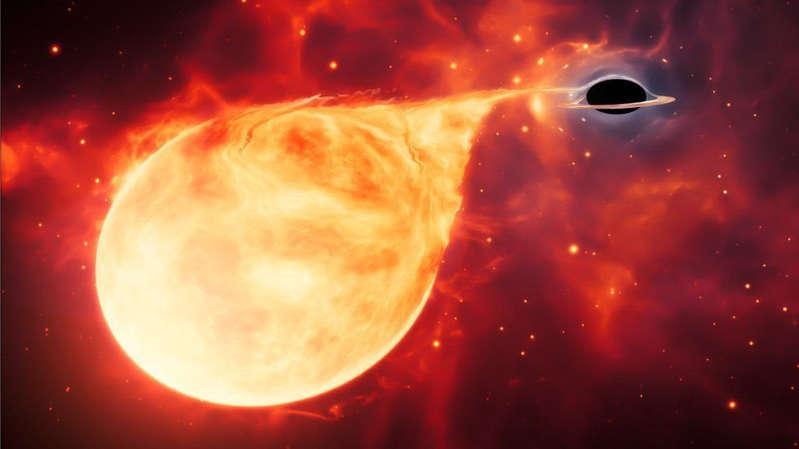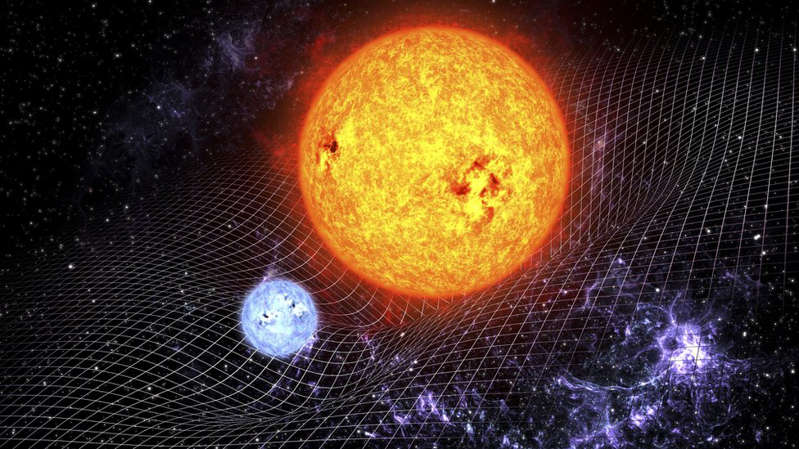Scientists from Ohio State University discovered a unique black hole that broke two astronomical records at once.
First, it is located closest to all others to our solar system – the distance to it is almost three times less than to the previous “record holder”.
Secondly, of all such objects ever discovered, this one is the smallest. So much so that it does not fit into the existing classification – for it you will have to come up with a new category.
Of course, a black hole can be called “tiny” only by cosmic standards: it is still about three times heavier than the Sun, that is, almost a million times the mass of our planet.
“Close” – when talking about the distance between astronomical objects – the concept is also very relative. The discovered black hole is located in the same galaxy, the Milky Way, in the constellation Unicorn, but it is still about 1500 light years away from Earth.
However, by cosmic standards, this is really almost a stone's throw. For comparison, the supermassive black hole Sagittarius A * located in the center of the Milky Way is about 18 times farther from Earth.
- “The mysteries of the Universe covered with darkness”. Nobel Prize in physics awarded for black holes
- An explosion of unprecedented power shook space. This has not happened since the Big Bang
And the one-of-a-kind photograph, published by scientists two years ago, captures the event horizon of a black hole (Messier 87), from where light traveled to Earth about 36,000 times longer.
The authors of the discovery have already dubbed the dwarf black hole the Unicorn – for its uniqueness and location. And since in English the constellations have traditional Latin names, the title of the article published on this subject (A Unicorn in Monoceros) is a play on words and translates as “Unicorn in a Unicorn”.
“The fact that such a black hole has been found in our galaxy is amazing news,” Oliver Jenrich, head of astrophysical research at the European Space Agency, told the BBC. find other black holes of stellar mass that have not yet been detected by traditional methods. “
What is a black hole?

Usually black holes are revealed due to their interaction with other cosmic bodies – for example, when it devours a nearby star.
- A black hole is a region of space-time in which the force of gravity is so great that no objects or waves, including light, can leave it.
- Despite the name, the black hole is not actually empty on the inside. On the contrary, it is filled with a huge mass of matter, compressed into a small volume, which creates a huge force of attraction
- Around the black hole is an area called the event horizon. This is an imaginary boundary in space, a “point of no return”, after crossing which it is no longer possible to escape from the gravitational trap.
Dwarfs and overgrown
Black holes are the most mysterious and incomprehensible astronomical objects.
Their physical properties, predicted by Albert Einstein back in 1915, are so different from the world we are used to that they don’t fit into our heads.
It is difficult even to imagine a black hole – after all, all the laws of physics known to us cease to operate there. Any attempts to calculate the characteristics of such objects using equations as a result either give infinity, or even lose all meaning.
In theory, black holes can be of very different sizes – from very tiny ones, formed at the dawn of the Universe (they are called primary), to real giants, whose mass exceeds the solar mass by tens of billions of times.
There are many such supermassive black holes (SMBHs): they are located in the center of many galaxies, including our Milky Way. However, until now, scientists have not been able to find a black hole with a mass less than five solar masses.
“The discovery of any small black hole is always exciting,” says Dr. Phil Sutton, who teaches astrophysics at the University of Lincoln. “They are much more interesting than their overgrown cousins located in the centers of galaxies, primarily due to the mechanism of their formation. “.

Massive objects bend space and time around them
Given the relative “lightness” of the discovered object, it is likely that the Unicorn was once a large star, the astrophysicist explains. It is especially interesting that its mass – only three times that of the sun – is literally on the verge of the minimum possible so that at the end of its life cycle, a star could turn into a black hole.
This is usually the case. When the reserves of fuel in the interior of a star come to an end, thermonuclear processes there begin to fade – and at some point, like a whale thrown onto land, it ceases to support its own weight. Then, under the influence of its own gravity, the star sharply “collapses”, as if falling inside itself, and turns into something else – but what exactly depends on its size and mass.
“If it were even smaller, and the result would be a neutron star,” continues Dr. Sutton. “In terms of mass, such stars are very slightly inferior to black holes, but when they collapse, they do not collapse to a minimum, but decrease to about the size of a city. Considering the proximity to us of the open object and the presence of a companion star with which they form a binary system, we can learn a lot about their evolution. “
However, the expert urges not to make hasty conclusions: the only parameter of the discovered celestial body in which scientists can be relatively confident is its mass.
Ripples across the universe
However, it is the unicorn's mass that is its most surprising characteristic, insists Dr. Darren Baskill, who teaches astronomy at the University of Sussex.
If a neutron star is formed during the collapse of a star whose mass exceeds the solar mass by 1.5-3 times, and the lightest black holes are at least five times heavier than the Sun, then what happens to a body of intermediate mass? Scientists are inclined towards the second option, but they have not yet been able to find experimental confirmation of this hypothesis.
“Our galaxy is literally stuffed with black holes that were formed as a result of the death of heavy stars,” Baskill is sure. “And the best way to detect them is to observe such binary systems. Light cannot escape from a black hole – but we can learn a lot by observing behind her companion star. “
This opinion is shared by his colleague, professor of gravitational astrophysics Martin Hendry.
“For quite some time now, astronomers have wondered whether such a 'mass gap' really exists?” Explains Hendry, who heads the School of Physics and Astronomy at the University of Glasgow. unknown species “.
Professor Hendry is one of the employees of the international project LIGO, who in September 2015 managed to experimentally confirm the existence of gravitational waves predicted by Albert Einstein in the framework of general relativity. In 2017, this discovery was awarded the Nobel Prize in Physics.
Imagine a lake as smooth as a mirror, into which, right before your eyes, someone decided to throw a decent size cobblestone. Having hit the water, the stone, of course, will immediately go to the bottom, and waves will begin to spread in circles on the surface of the lake from the place of the fall.
Gravitational waves are exactly the same “ripples” that spread across the fabric of space-time when objects of huge mass, like two black holes, collide.
Over the past five years since then, scientists have managed to record dozens of cases when, as a result of the merger of two black holes, the Universe was permeated by gravitational oscillations. But the signal discovered last June, according to Professor Hendry, left physicists at a standstill.
One of the colliding objects was definitely a compact black hole, but scientists still argue about the nature of the second: whether it was the heaviest neutron star ever discovered, or the lightest black hole ever discovered. Discovered in the neighborhood of the Unicorn gives astronomers hope that it will be possible to put an end to this issue.
However, it is too early to guess. As recently as last year, scientists already announced that they had found a similar object – and even closer to our planet, at a distance of only 1000 light years.
However, within a few months, one after another, four papers were published at once, challenging this discovery and offering convincing alternative explanations for the measurements made.

